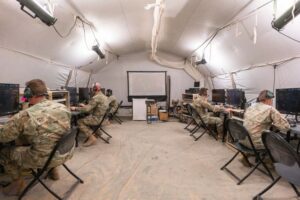The Army has completed the final assessment during the initial operational test and evaluation (IOT&E) period for Northrop Grumman’s [NOC] Integrated Air and Missile Defense Battle Command System (IBCS), the company said Tuesday.
Northrop Grumman noted the completion of the 10-month IOT&E phase for IBCS is “the last major test event” before the Army is set to move the program into full-rate production.

IBCS is the U.S. Army’s future missile defense command platform, designed to integrate and connect the service’s full range of “sensor to shooter” capabilities.
The Army last December awarded Northrop Grumman a potential $1.4 billion deal for IBCS production, covering delivery of up to 160 systems (Defense Daily, Dec. 23).
Northrop Grumman noted the 10-month IOT&E for IBCS began in January, with the Army running a series of operational flight tests at White Sands Missile Range in New Mexico.
“Throughout the 10-month period, soldiers operated IBCS in complex test environments encompassing a broad spectrum of attack and defense scenarios under realistic operating conditions, stressing the system as never before, and under intense scrutiny by U.S. Army independent evaluators,” the company wrote in a statement.
Northrop Grumman in March detailed the initial two successful flight tests with IBCS during the first phase of IOT&E, one that involved intercepting a high-speed tactical ballistic missile and another where two cruise missile targets were taken out “in a stressing electronic attack environment” (Defense Daily, March 17).
The Army has previously noted a third flight test was slated this fall for the second phase of IOT&E, with Northrop Grumman describing the operational evaluation as concluding with a “final, demanding assessment.”
A full-rate production for IBCS is slated for fiscal year 2023, the Army has previously said.
Northrop Grumman on Nov. 3 noted IBCS participated in the Army’s Project Convergence experiment this fall, to include successfully demonstrating “the capability for IBCS to provide data for offensive fires for the first time in support of long-range precision fires objectives.”
“IBCS rapidly integrated a U.S. Marine Corps sensor, Marine Expeditionary Littoral Persistent Sensor (MELPS), allowing information to disseminate to the U.S. Navy’s Cooperative Engagement Capability (CEC) fire control network. Additionally, there was an airspace command and control (AC2) interface with the U.S. Air Force to provide increased situational awareness,” the company wrote on its Project Convergence participation. “Another experiment demonstrated IBCS’ ability to integrate with a new interceptor uplink for communicating with a missile in flight, now adding another option where historically only the Patriot radar system was used. This new capacity provides the warfighter more flexibility in deploying sensors and effectors across the battlefield.”